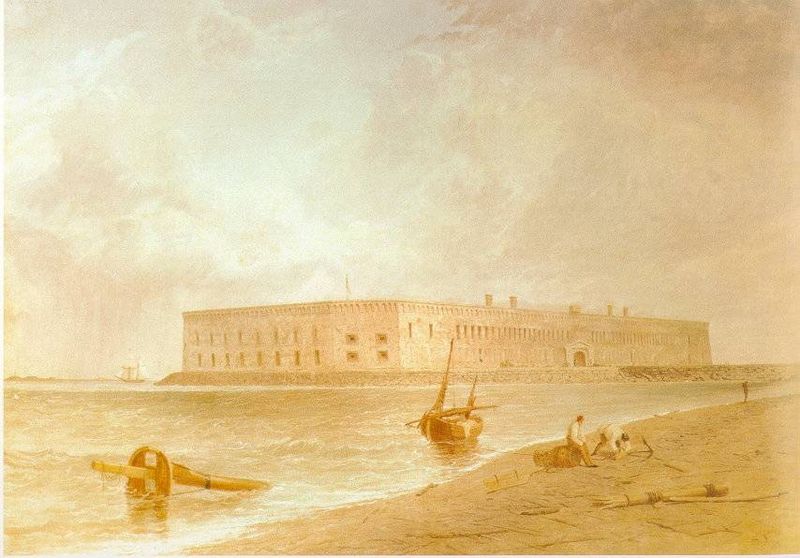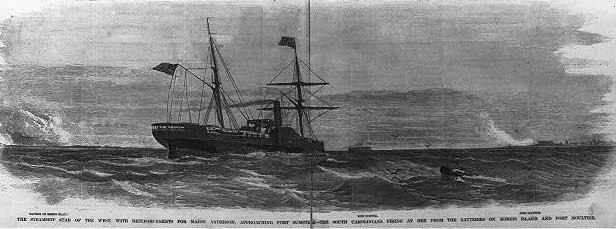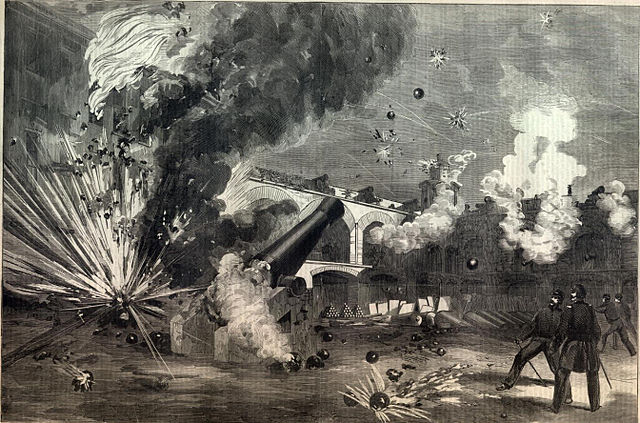
You learned about the tensions that led to war between the North and the South. The election of Abraham Lincoln in 1860 seemed to be the last straw for the South. On December 20, 1860, the South succeeded, or separated, from the Union.
On December 25, Union troops withdrew to Fort Sumter, a secluded fort off the coast of South Carolina. The North believed the fort belonged to the federal government, and the South thought it belonged to the new Confederate States. Four months later, this would be the site of the first engagement in the Civil War.
Read the following information about Fort Sumter and the first engagement of the Civil War. Take notes as you read.

Steamship Star of the West, with reinforcements for Major Anderson, approaching Fort Sumter
The South soon tested President Lincoln’s vow to hold federal property. Five days after South Carolina seceded in December 1860, 68 federal troops stationed in Charleston, South Carolina, withdrew to Fort Sumter, an island in Charleston Harbor. The North considered the fort to be the property of the United States government, but Confederate forces had already seized some United States forts within their states. Although Lincoln did not want to start a war by trying to take the forts back, allowing the Confederates to keep them would amount to admitting their right to secede.
On the day after his inauguration, Lincoln received a dispatch from the commander of Fort Sumter, Major Robert Anderson, a former slave owner who was nevertheless unquestionably loyal to the Union. The message warned that the fort was low on supplies and that the Confederates demanded its surrender. With 6,000 South Carolina militia surrounding the harbor, Anderson and his soldiers were cut off from reinforcements and supplies. In fact, In January 1861, as one of his last acts, President Buchanan sent 200 soldiers and supplies on an unarmed merchant vessel, Star of the West, to reinforce Anderson. It quickly fled when South Carolina artillery opened fire.

Artwork depicting the bombardment of Fort Sumter
Lincoln responded by sending a message to Governor Francis Pickens of South Carolina on April 6. He informed Pickens that he was sending an unarmed expedition with supplies to Fort Sumter. Lincoln promised that Union forces would not “throw in men, arms, or ammunition” unless they were fired upon. The president left the decision to start shooting up to the Confederates.
Confederate president Jefferson Davis and his advisers made a fateful choice. Davis decided he had no choice but to order Anderson to surrender to Sumter. Anderson refused. Davis ordered their forces to attack Fort Sumter before the Union supplies could arrive. Confederate guns opened fire on the fort at 4:30 a.m. on April 12. Confederate artillery, under the command of General P.G.T. Beauregard, opened fire on Fort Sumter. Confederate batteries showered the fort with over 3,000 shells in a three-and-a-half-day period.
High seas had prevented Union relief ships from reaching the besieged fort. The Union garrison held out for 33 hours before surrendering on April 14. Thousands of shots were exchanged during the siege, but there was no loss of life on either side. The Confederates hoisted their flag over the fort, and all the guns in the harbor sounded a triumphant salute. News of the attack galvanized the North. Lincoln issued a call for 75,000 troops to fight to save the Union, and volunteers quickly signed up. Meanwhile, Virginia, North Carolina, Tennessee, and Arkansas voted to join the Confederacy. The Civil War had begun.
| Who was chosen to be the provisional president of the Confederate States of America? | Jefferson Davis |
| Why did Lincoln hesitate to send troops to help those at Fort Sumter? | He didn't want to aggravate the delicate situation and drive more states to join the Confederacy. |
| Which side attacked first? | The South attacked first to prevent Lincoln from resupplying his troops at Fort Sumter. |
